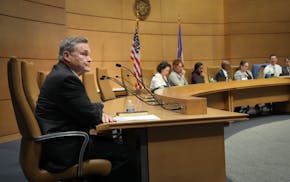South metro cities, grappling with the economy and a change in an important state tax credit, are all over the map in their fiscal and political strategies as they set tax levies for 2012.
As city councils across Scott and Dakota counties voted on maximum tax levies -- the highest amount they can request from taxpayers -- some opted for increases of up to 11 percent while others dropped the levy by nearly 6 percent.
Despite the range, some commonalities have emerged:
Cities with the largest percentage hikes in their levy are trying to reconfigure their finances by weaning themselves off unreliable state aid or, in Farmington's case, building savings to avoid future borrowing and interest payments for big projects.
Others are straining to hold the line. With city elections looming, Savage will pull $525,000 out of reserves to avoid increasing the tax levy. The result, said finance chief Shelly Kolling: "If your property value decreased the average amount -- approximately two percent -- your city share of property taxes for 2012 should stay about the same."
More than in most years, the impact on individual tax bills for homeowners and businesses is far from certain. No increase in the levy doesn't necessarily mean no increase in an individual's taxes.
Many cities are still calculating the effects of this year's switch from the state's old homestead credit to a new homestead "market value exclusion."
The change takes away a state payment to local government and decreases residential property value for tax purposes. It will likely help people with less expensive homes and shift some of the tax burden onto those with homes valued at $414,000 or more, plus commercial and industrial properties.
For 2012, during the transition to the new system, officials expect many residents to see rising tax bills even in cities where the total levy declines or stays flat.
And there's confusion beyond that. Take Prior Lake, for instance, which says it's holding the levy even. Dissenting council members argued in a typically contentious meeting earlier this month that such a claim is deceptive.
"I know it's nice to say we aren't increasing the levy," said Mayor Mike Myser, "but we are collecting more money." Added colleague Richard Keeney: "Look at the cash, that cuts through the baloney: It's going up 3.6 percent."
Council Member Warren Erickson countered that the spending is taking care of legitimate needs, but added that it's just a maximum: "I think we will go down from here; we will find more areas to tweak this budget to get it to the right level."
Finance Director Jerrilyn Erickson meanwhile cautioned on Friday that the 3.6 percent figure is skewed by a fund transfer from reserves to handle maintenance needs. Subtracting that "would bring it down to less," she said.
The theme of unmet needs was being voiced in Shakopee as well. That city is expected to raise taxes in what finance director Julie Linnihan reminded council members is "the first increase in a number of years," aimed at filling "significant needs" that have been building up in the domains of public safety, personnel and infrastructure.
The City Council vote was 4-1, with newcomer Pamela Punt dissenting.
The West St. Paul City Council approved an increase of up to 4.6 percent, driven largely by a desire to remove unpredictable state aid from the city budget. They said they expected to see the numbers come down before voting on a final levy and budget in December.
"We have a lot of work to do as a council between now and then," said Council Member Dave Wright, echoing counterparts in other cities. "It's not automatic. It's a starting point."
Homeowners' final property tax bills are also affected by tax levies set by counties and school districts. At the county level, Scott and Dakota both decided last week to keep their levies more or less steady; Dakota's will stay the same, while Scott's will increase by a maximum of just under 1 percent.
Staff writers Jim Adams and Heron Marquez Estrada contributed to this report.

GOP senators grill Sen. Nicole Mitchell's attorneys during ethics hearing about her burglary charge

Ethics panel takes up complaint against Republican senator who sent graphic video link
White Earth tribal member charged with felony cannabis possession after raid on tobacco shop
